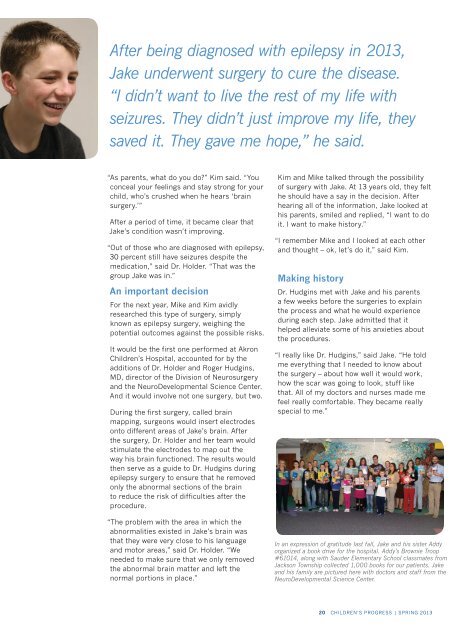Making History - Akron Children's Hospital
Making History - Akron Children's Hospital
Making History - Akron Children's Hospital
You also want an ePaper? Increase the reach of your titles
YUMPU automatically turns print PDFs into web optimized ePapers that Google loves.
After being diagnosed with epilepsy in 2013,<br />
Jake underwent surgery to cure the disease.<br />
“I didn’t want to live the rest of my life with<br />
seizures. They didn’t just improve my life, they<br />
saved it. They gave me hope,” he said.<br />
“As parents, what do you do?” Kim said. “You<br />
conceal your feelings and stay strong for your<br />
child, who’s crushed when he hears ‘brain<br />
surgery.’”<br />
After a period of time, it became clear that<br />
Jake’s condition wasn’t improving.<br />
“Out of those who are diagnosed with epilepsy,<br />
30 percent still have seizures despite the<br />
medication,” said Dr. Holder. “That was the<br />
group Jake was in.”<br />
An important decision<br />
For the next year, Mike and Kim avidly<br />
researched this type of surgery, simply<br />
known as epilepsy surgery, weighing the<br />
potential outcomes against the possible risks.<br />
It would be the first one performed at <strong>Akron</strong><br />
Children’s <strong>Hospital</strong>, accounted for by the<br />
additions of Dr. Holder and Roger Hudgins,<br />
MD, director of the Division of Neurosurgery<br />
and the NeuroDevelopmental Science Center.<br />
And it would involve not one surgery, but two.<br />
During the first surgery, called brain<br />
mapping, surgeons would insert electrodes<br />
onto different areas of Jake’s brain. After<br />
the surgery, Dr. Holder and her team would<br />
stimulate the electrodes to map out the<br />
way his brain functioned. The results would<br />
then serve as a guide to Dr. Hudgins during<br />
epilepsy surgery to ensure that he removed<br />
only the abnormal sections of the brain<br />
to reduce the risk of difficulties after the<br />
procedure.<br />
“The problem with the area in which the<br />
abnormalities existed in Jake’s brain was<br />
that they were very close to his language<br />
and motor areas,” said Dr. Holder. “We<br />
needed to make sure that we only removed<br />
the abnormal brain matter and left the<br />
normal portions in place.”<br />
Kim and Mike talked through the possibility<br />
of surgery with Jake. At 13 years old, they felt<br />
he should have a say in the decision. After<br />
hearing all of the information, Jake looked at<br />
his parents, smiled and replied, “I want to do<br />
it. I want to make history.”<br />
“I remember Mike and I looked at each other<br />
and thought – ok, let’s do it,” said Kim.<br />
<strong>Making</strong> history<br />
Dr. Hudgins met with Jake and his parents<br />
a few weeks before the surgeries to explain<br />
the process and what he would experience<br />
during each step. Jake admitted that it<br />
helped alleviate some of his anxieties about<br />
the procedures.<br />
“I really like Dr. Hudgins,” said Jake. “He told<br />
me everything that I needed to know about<br />
the surgery – about how well it would work,<br />
how the scar was going to look, stuff like<br />
that. All of my doctors and nurses made me<br />
feel really comfortable. They became really<br />
special to me.”<br />
In an expression of gratitude last fall, Jake and his sister Addy<br />
organized a book drive for the hospital. Addy’s Brownie Troop<br />
#61014, along with Sauder Elementary School classmates from<br />
Jackson Township collected 1,000 books for our patients. Jake<br />
and his family are pictured here with doctors and staff from the<br />
NeuroDevelopmental Science Center.<br />
20 CHILDREN’S PROGRESS | SPRING 2013



